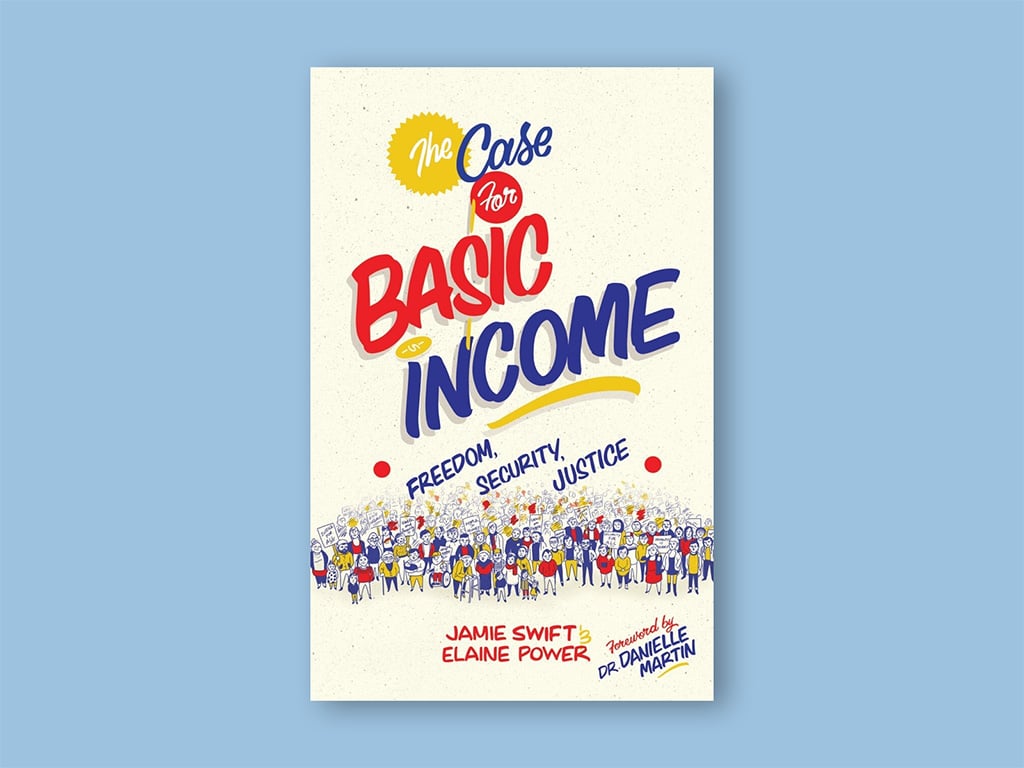The Case for Basic Income
By Jamie Swift and Elaine Power
Between the Lines (2021)
“The good we secure for ourselves is precarious and uncertain, is floating in mid-air, until it is secured for all of us and incorporated into our common life.”
When American activist and social worker Jane Addams wrote these words in 1893, the world was in the heyday of its first run with free-market capitalism and liberalism. Ideas about the “common good” were not popular in the mainstream. The Industrial Revolution of the late 18th and early 19th centuries had paved the way for a cultural shift away from local economies and communal dependence. In Europe and North America, society’s focus was on mechanization, large-scale growth and a bootstraps-and-grit ethic that dictated an “every person for themselves” approach to life and work.
It was an ideology that would become deeply entrenched in western culture, and that we are still immersed in today, argue journalist Jamie Swift and academic Elaine Power.
In their new book, The Case for Basic Income, the duo presents an alternative vision for post-pandemic existence after a year that has exposed the fallacies of neoliberalism and the reality of our interconnectedness and interdependence. It’s a proposal that once seemed radical but is gaining increasingly widespread traction and appeal: a universal basic income.
The concept of basic income (colloquially known as “BI” or “UBI”) is not new. In fact, it’s much older, and more tried and tested, than its critics give it credit. This is a pillar of Swift and Power’s exploration of the policy. No stone is left unturned in their thorough and convincing argument in favour of a basic income.
Though the book focuses primarily on Canada’s history with basic income, the authors acknowledge its antecedents, both literal and imagined, all the way back to the publication, in 1516, of Thomas More’s Utopia. The idea of providing a fixed income for all members of society to meet their basic needs and, in doing so, escape cycles of poverty, instability and ill health, is not simply a utopian ideal, they conclude. It’s a well-studied and financially viable option that would benefit Canada’s economy and social fabric immensely.
The Case for Basic Income opens with a short foreword by an Ontario-based family physician who writes of her concern for her patients at the outset of the COVID-19 pandemic. While she worried about an 86-year-old man who lived on his own and a young woman pregnant with her first child, she was most preoccupied with the well-being of a small dance studio owner who went out of business within the first few weeks of the pandemic. She knew how much the financial loss would affect her and, as a health equity advocate, she also knew that financial insecurity often leads to poor health outcomes.
Luckily for this doctor’s patient, and for many thousands of Canadians, this woman was offered a life raft: the Canada Emergency Response Benefit, which provided $2,000 per month in guaranteed income. Along with the Canada Emergency Wage Subsidy, which subsidized employee wages for eligible businesses, the CERB provided temporary security and relief from the stress of losing work, something a large portion of the country’s population (some 5.5 million people) experienced when COVID hit.
The fact that the government was able to provide this emergency support so quickly, and with few bureaucratic hurdles for applicants, write Swift and Power, proves that what is often deemed impossible is actually not: expanding the social security net to include more people and to offer genuine support instead of crumbs.
While CERB was the closest Canada has come to a federal basic income program, it still left many out, and was dependent on meeting a previous employment threshold. People who had earned under $5,000 in 2019 were ineligible, along with those who had been unemployed previous to the pandemic or were coming off of EI or parental leave.
This is where basic income differs. Basic income programs are not tied to employment, and, unlike welfare and disability assistance, they do not require constant monitoring to determine eligibility and deservedness.
Swift and Power are unequivocal in their assessment of these systems: they are closer to policing than to a social service. Besides the difficulty of meeting eligibility criteria, once accepted for these programs recipients are punished for earning above a certain annual income on top of their assistance payments and must constantly prove their merit to government workers.
If a true basic income were to be implemented in Canada, it would mean moving beyond the limitations of our current thinking around social security, say Swift and Power. And, perhaps even more importantly, it would mean a transformational reimagining of work, labour, time and freedom.
For many Canadians, any mention of basic income is linked to Manitoba’s “Mincome” pilot program, launched in Winnipeg and the small town of Dauphin in 1975. Albeit short-lived (the program was cancelled by provincial and federal Conservative governments four years later), the resulting data is telling.
Health economist Evelyn Forget, spurred by her own experience with childhood poverty, decided to dig into it in 2008, later publishing her research in an article for Canadian Public Policy. What emerged was a resounding advertisement for the program’s benefits. During the period that residents received a guaranteed income of $16,000 (nearly $80,000 in today’s dollars), hospital visits dropped by nearly 10 per cent and both fertility rates and high school dropout rates also declined.
Swift and Power do not spend much time on the Mincome experiment — a topic that could have used more expansion, given its fascinating findings, as well as its place in the national imagination — instead zipping along to dive into two more recent basic income pilot programs, both in Ontario. Under the leadership of former Liberal premier Kathleen Wynne, the towns of Hamilton and Lindsay were both selected as trial sites for the Ontario Basic Income Pilot in 2017.
This program saw 4,000 low-income earners receive $17,000 if they were single and $24,000 if coupled, and included a $6,000 top-up for disabled people. For those working low-wage jobs while participating, their basic income was reduced by 50 cents for every dollar they earned, until they hit a ceiling of $34,000 for singles and about $48,000 for couples.
Again cut short by Conservatives — this time only several months in — the pilot program offered similarly striking results. And this is where Swift and Power’s book gains real momentum, as they zero in on the individuals positively impacted by the Ontario pilot program.
Drawing on examples from a range of backgrounds and circumstances — a single mother with a disabled daughter and three other children to care for; a disabled man struggling with precarious employment, mental health issues and food insecurity; a young millennial working a minimum-wage job and looking for more meaningful work — they show how even the relatively small annual amount each of these people received made an overwhelming difference in their lives. Families were able to pay off long-standing debt and stop using the food bank; individuals were able to pursue higher education or start small businesses.
The Case for Basic Income’s primary strength lies in its ability to connect these stories with the greater picture surrounding basic income. Like all good journalism, it uses the personal to shed light on the political and public, and in doing so, the book builds a solid and demonstrable defence for the approach. These real-world examples lend credibility to what basic income’s proponents often hold up as its main benefit: the freedom to choose a life of purpose and to live without the anxiety and fear that precarity and poverty entail, the reduced toll on the health-care system and the increased food security.
Swift and Power have studied basic income for years, so they know that it has met with resistance from both the political right and left, and that spotlighting its wins is not always enough. They devote equal attention to criticism against it, gently but firmly showing how it is often misguided.
For those on the right who believe giving a “handout” to everyone would simply discourage people from working, they argue that the poorest people in society are those that currently work the hardest: the (often racialized) workers the pandemic has deemed “essential” but not worth protecting with policies like paid sick leave. Basic income would offer some the opportunity to leave dangerous or exploitative working conditions, but it would also acknowledge undervalued forms of labour, such as (often gendered) care work.
For those on the left, who might fear that basic income would erode labour protections and government-worker unions, as well as endanger important public supports like medicare and non-market housing, the authors propose that liberating people from social assistance would free up public-sector workers to provide more preventative health services. Unions would remain critical to the labour movement, and access to subsidized health care, pharmacare, child care and housing options would be a key factor in the policy’s implementation, funded by a progressive taxation system.
Swift and Power don’t delve into the nitty-gritty of how basic income might be implemented at the national level in Canada, citing the “tricky policy knots” of our country’s provincial-federal jurisdictional issues. While it’s certainly a question that begs answering, the reality is that the details could likely make up their own book. And this one is about winning hearts and minds, not convincing skeptical economists.
Ultimately, they argue, basic income is about freedom. Not the freedom of unregulated capitalism — the current system we live in, that prioritizes corporations above people — but a more expansive, human one. In a world increasingly dominated by precarious labour and the gig economy, as well as by growing automatization of jobs, skyrocketing economic inequality and a global climate crisis, it would mean an intentional value shift. Away from the worship of growth and towards a whole-hearted, intentional sustainability.
It’s a powerful idea. And after the past year, and all the inequity, injustice and moral failings the pandemic has exposed, perhaps it’s one whose time has come. ![]()
Read more: Rights + Justice, Labour + Industry

















Tyee Commenting Guidelines
Comments that violate guidelines risk being deleted, and violations may result in a temporary or permanent user ban. Maintain the spirit of good conversation to stay in the discussion.
*Please note The Tyee is not a forum for spreading misinformation about COVID-19, denying its existence or minimizing its risk to public health.
Do:
Do not: